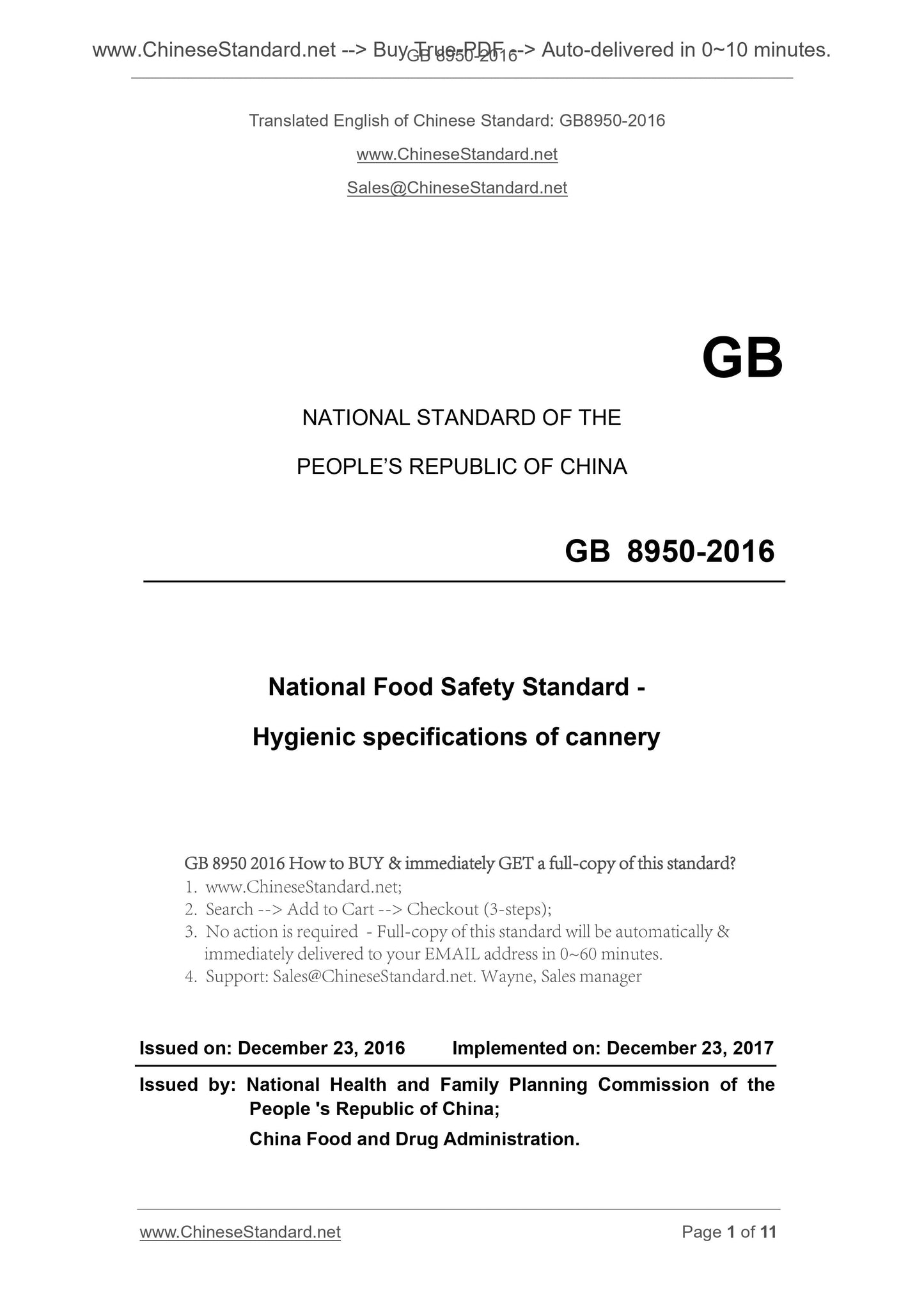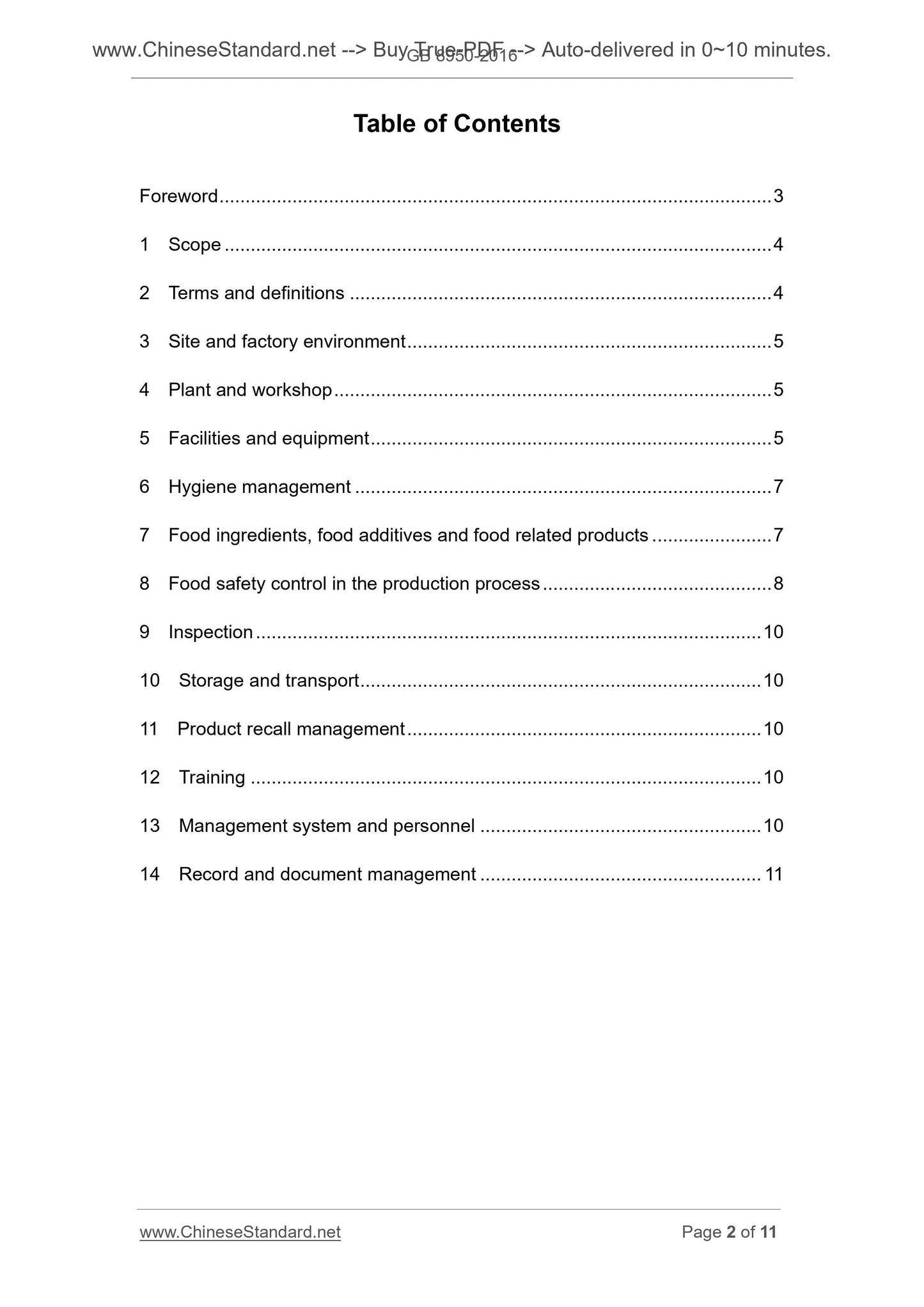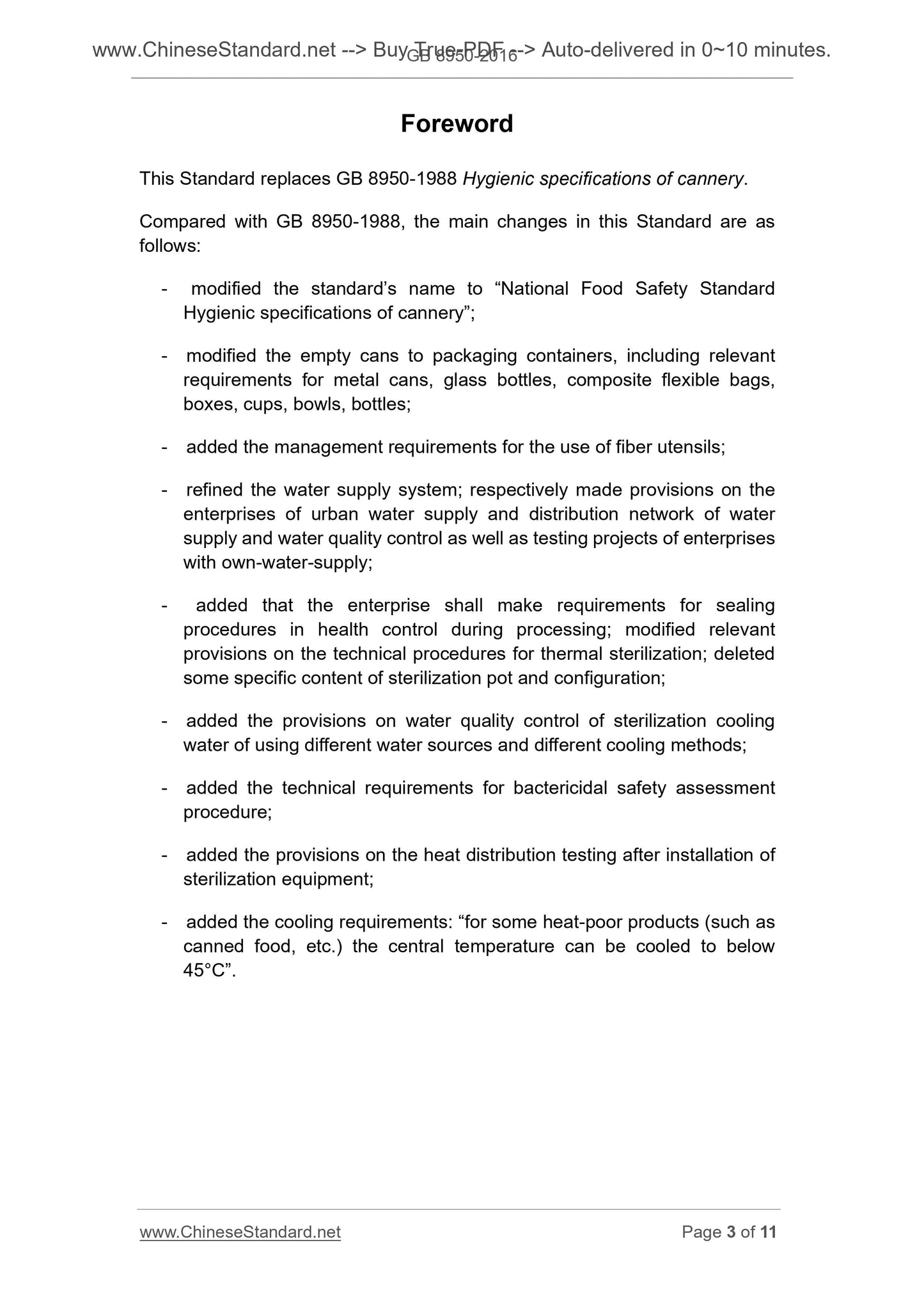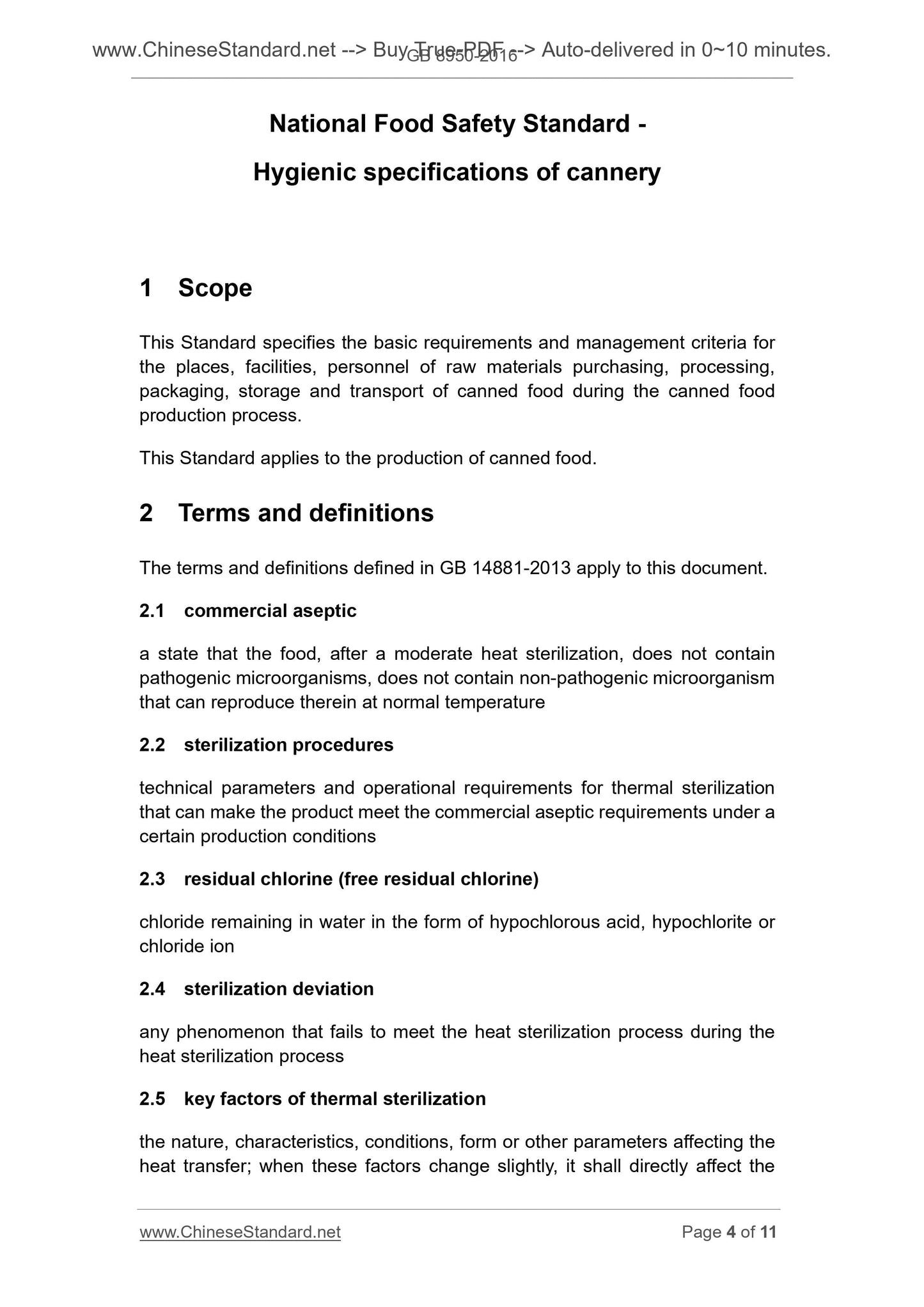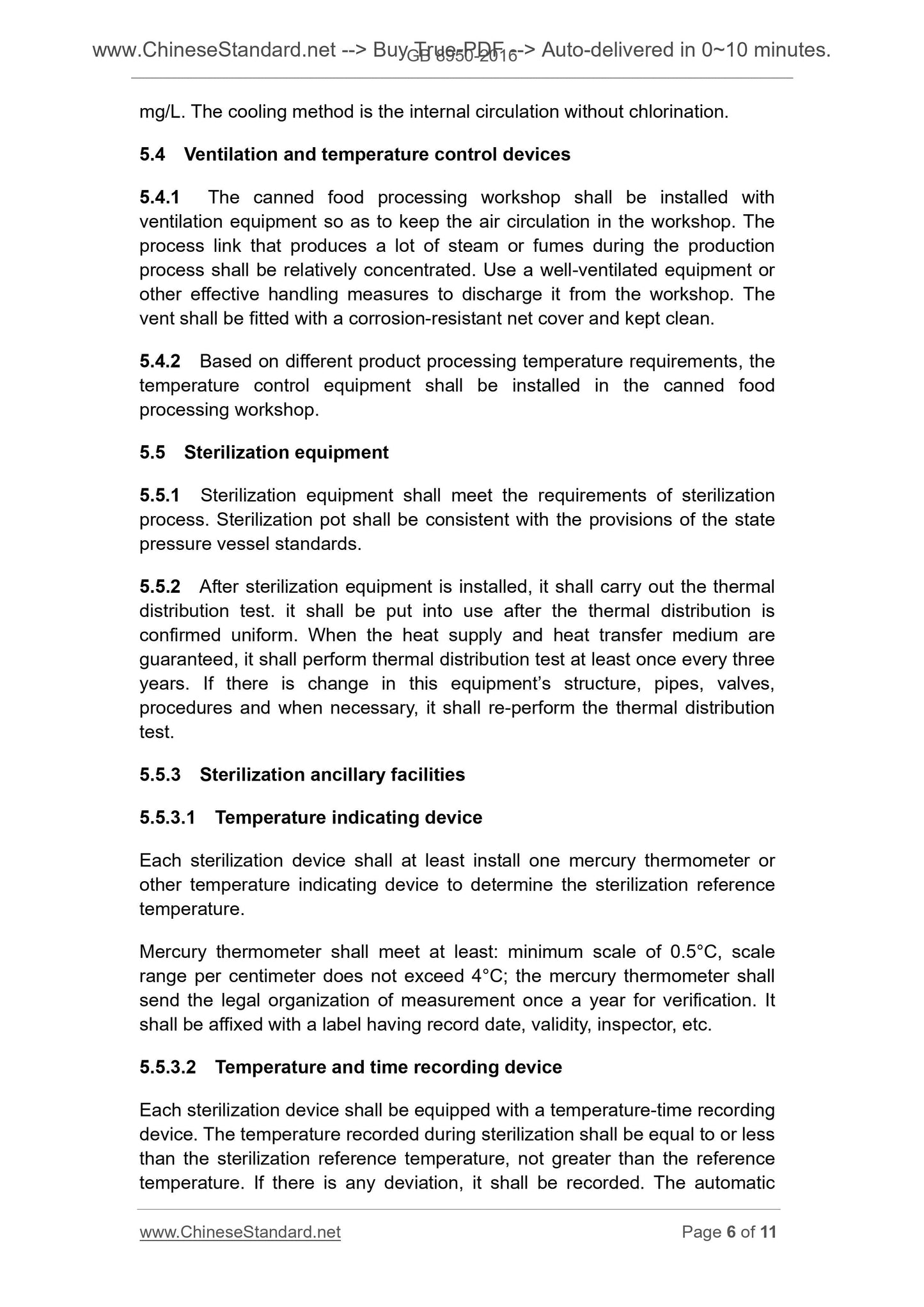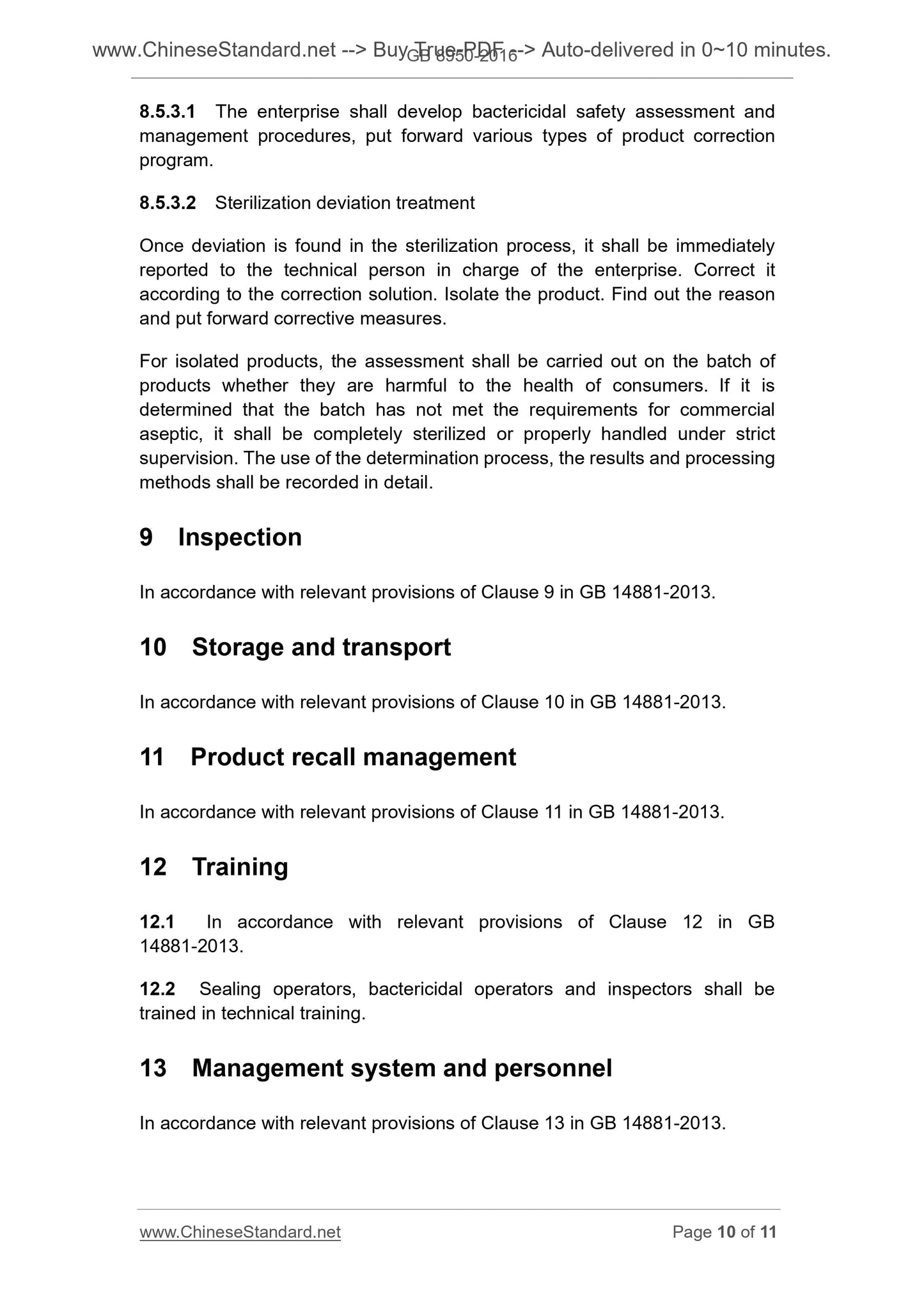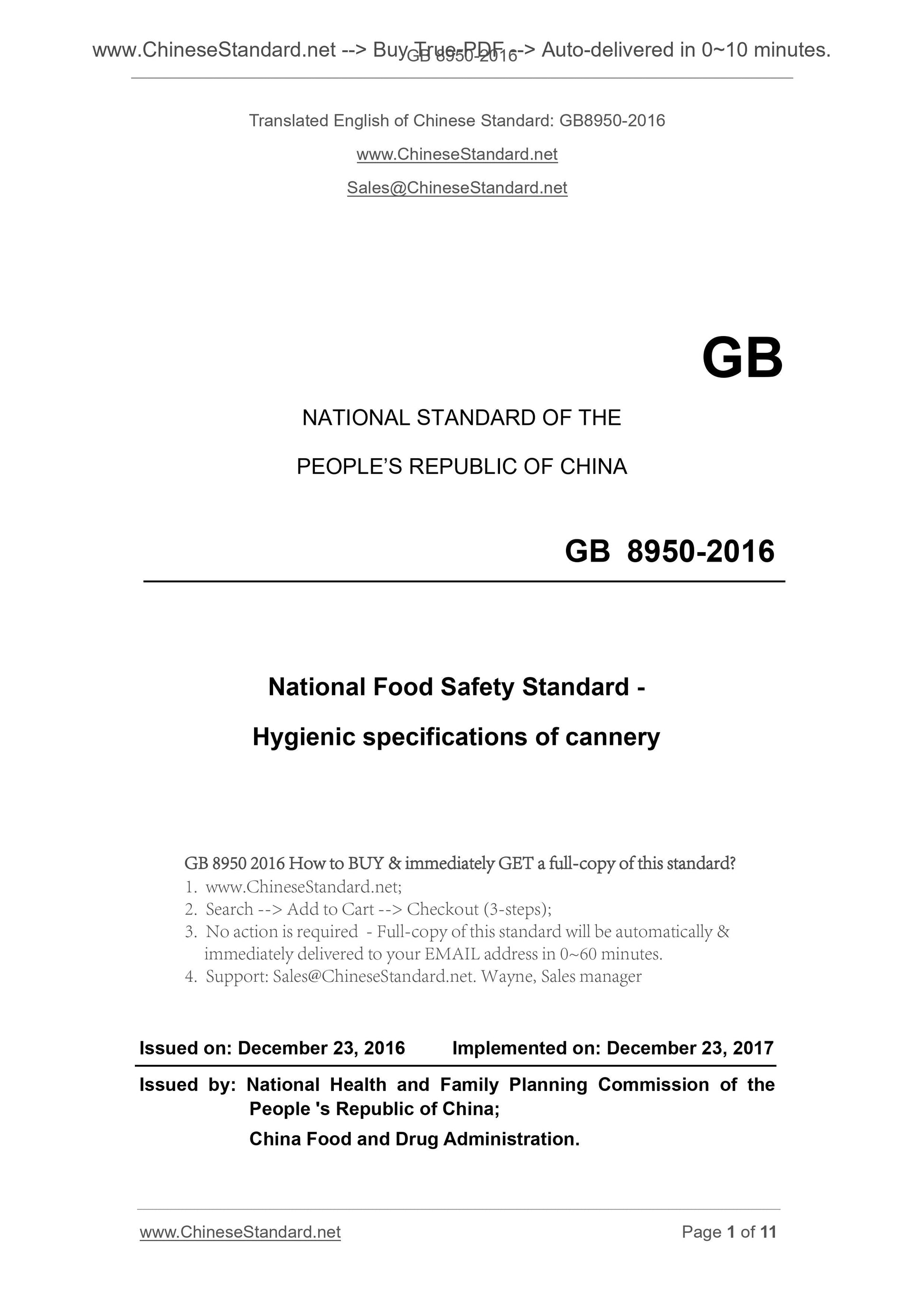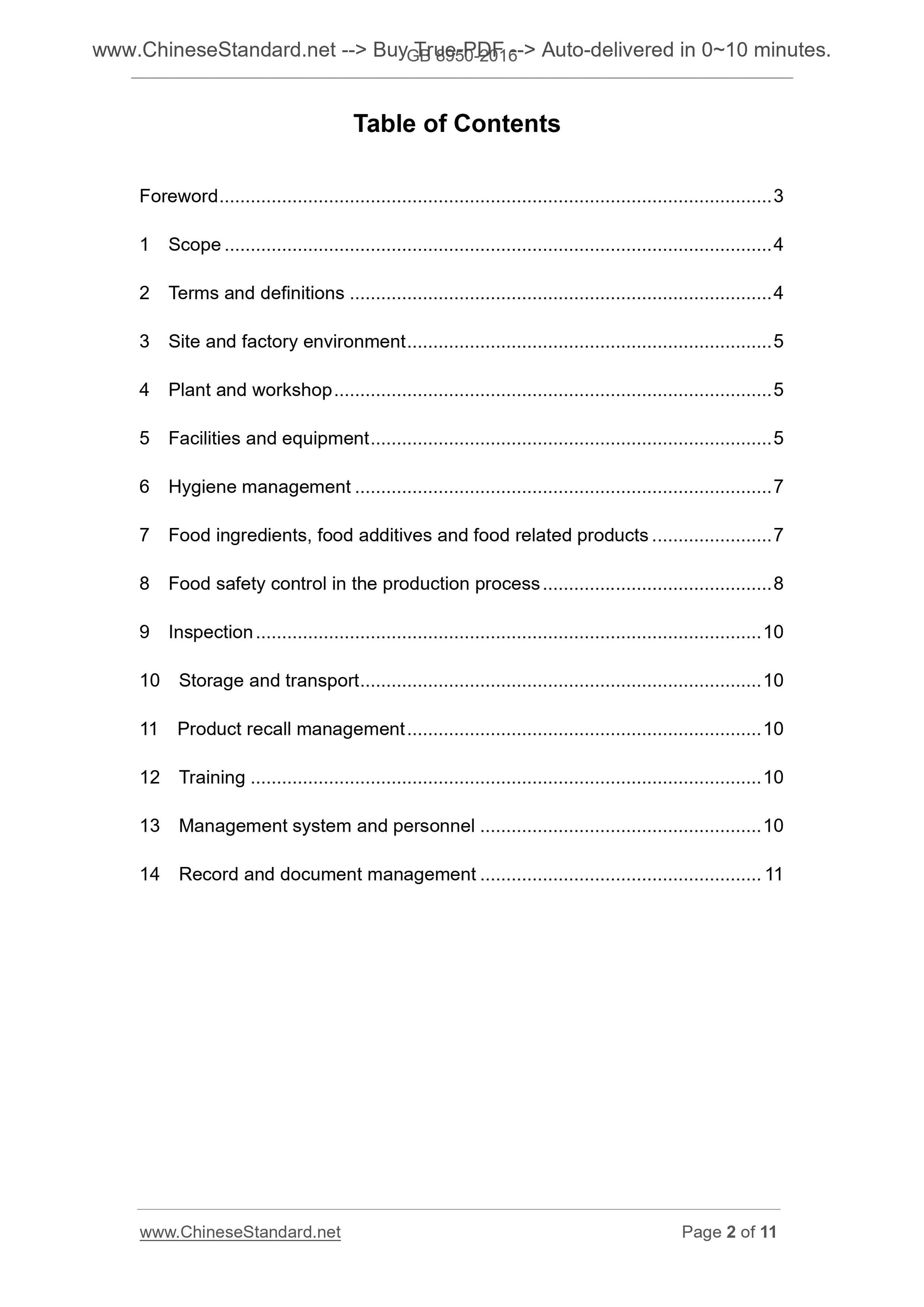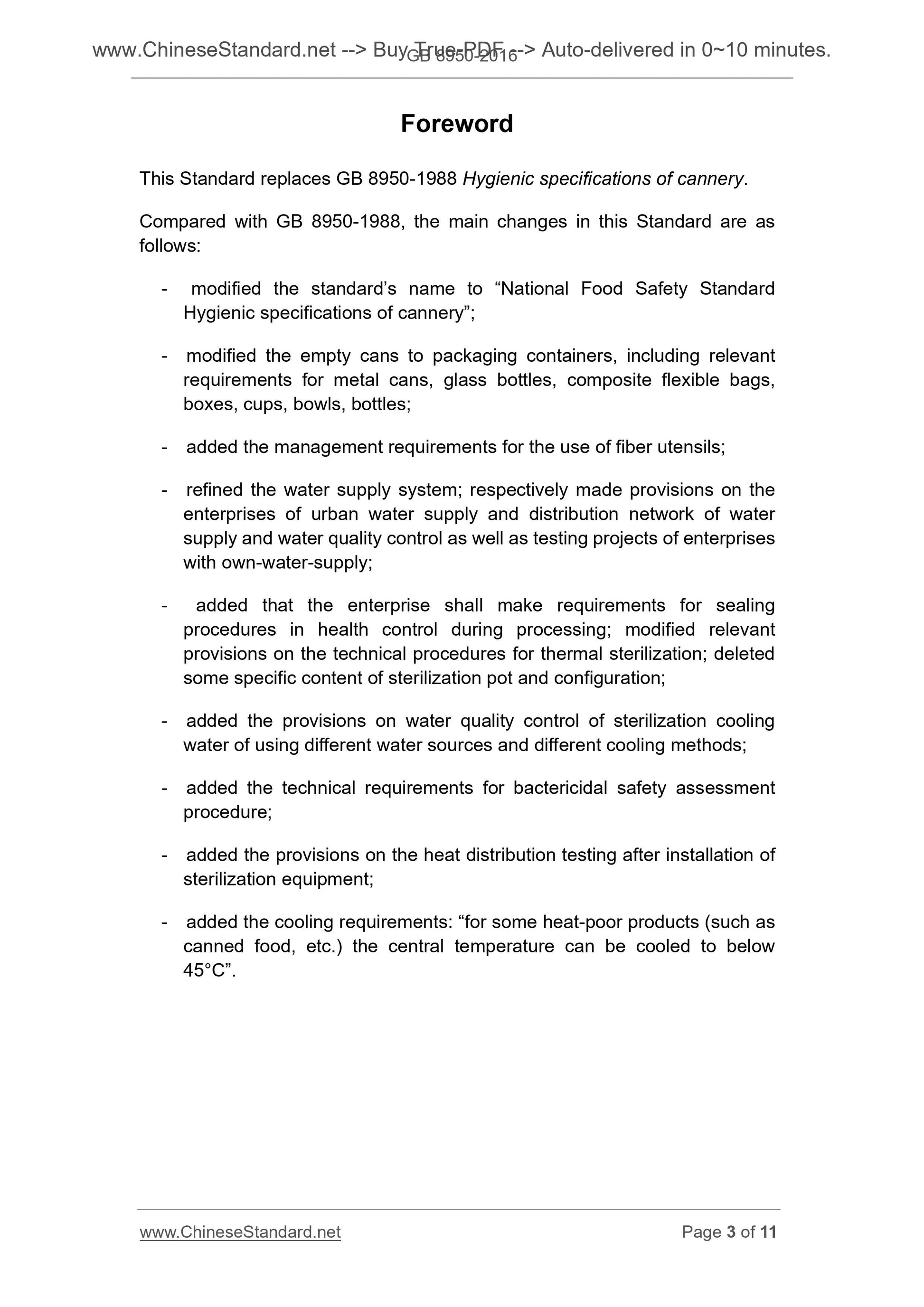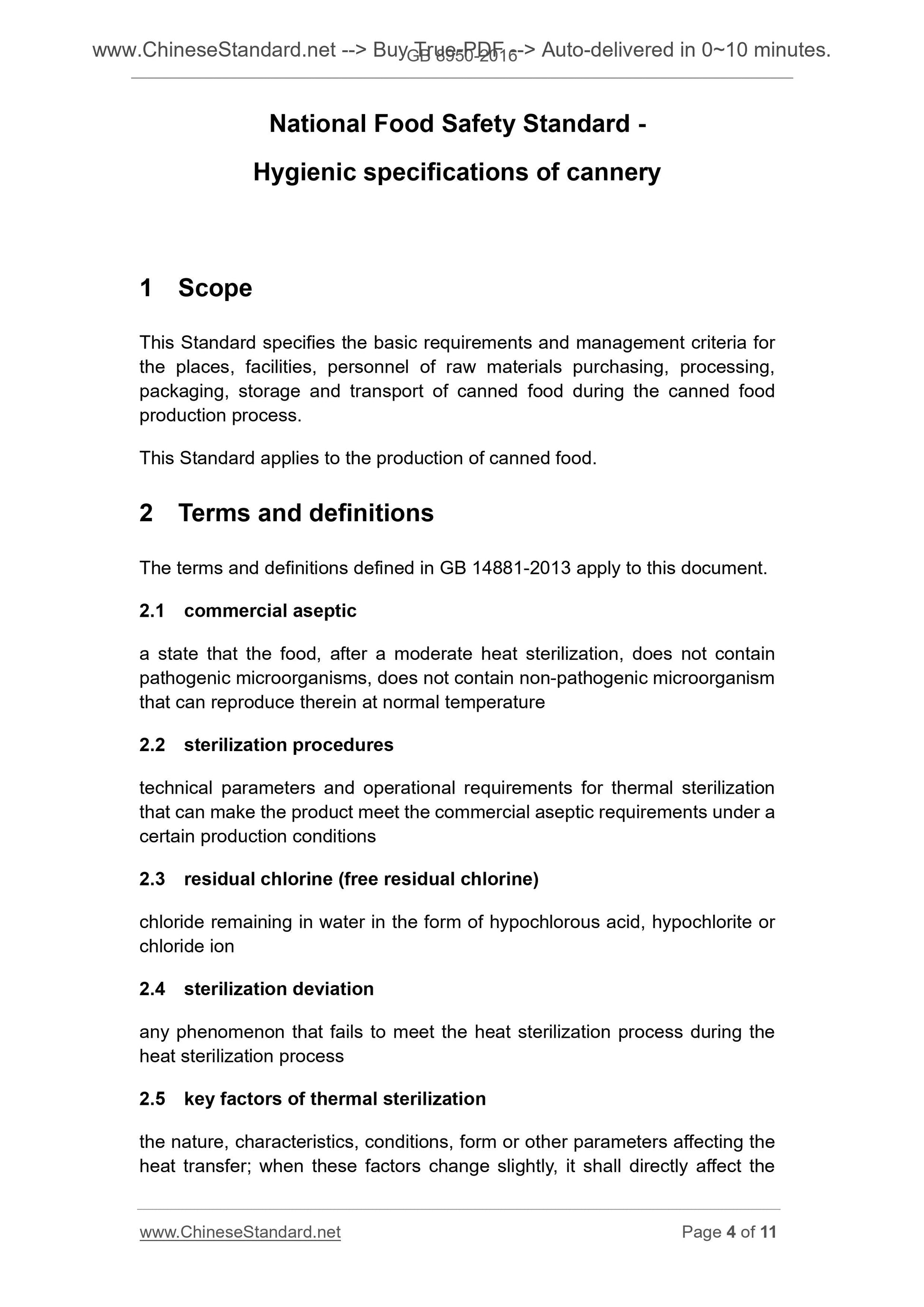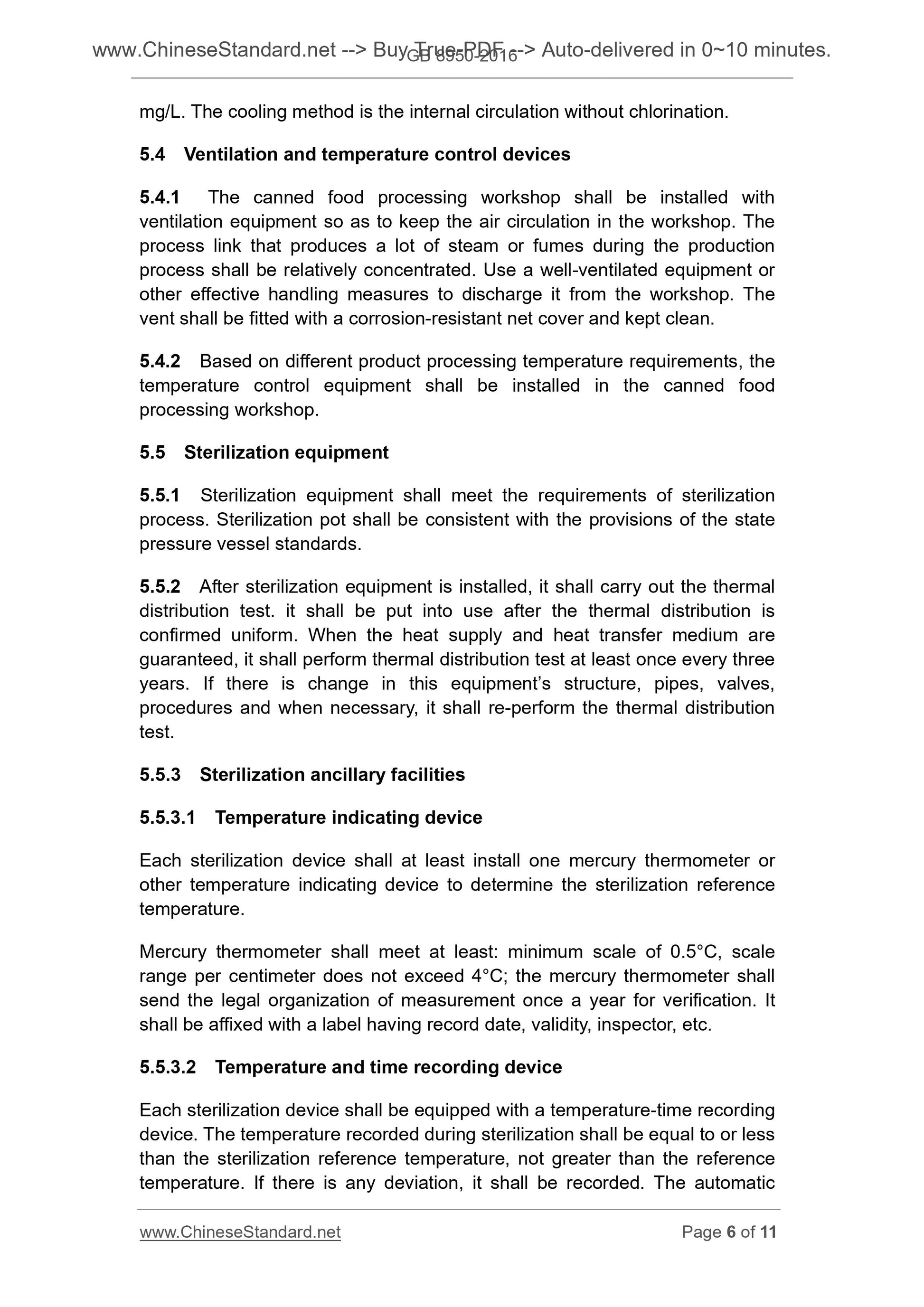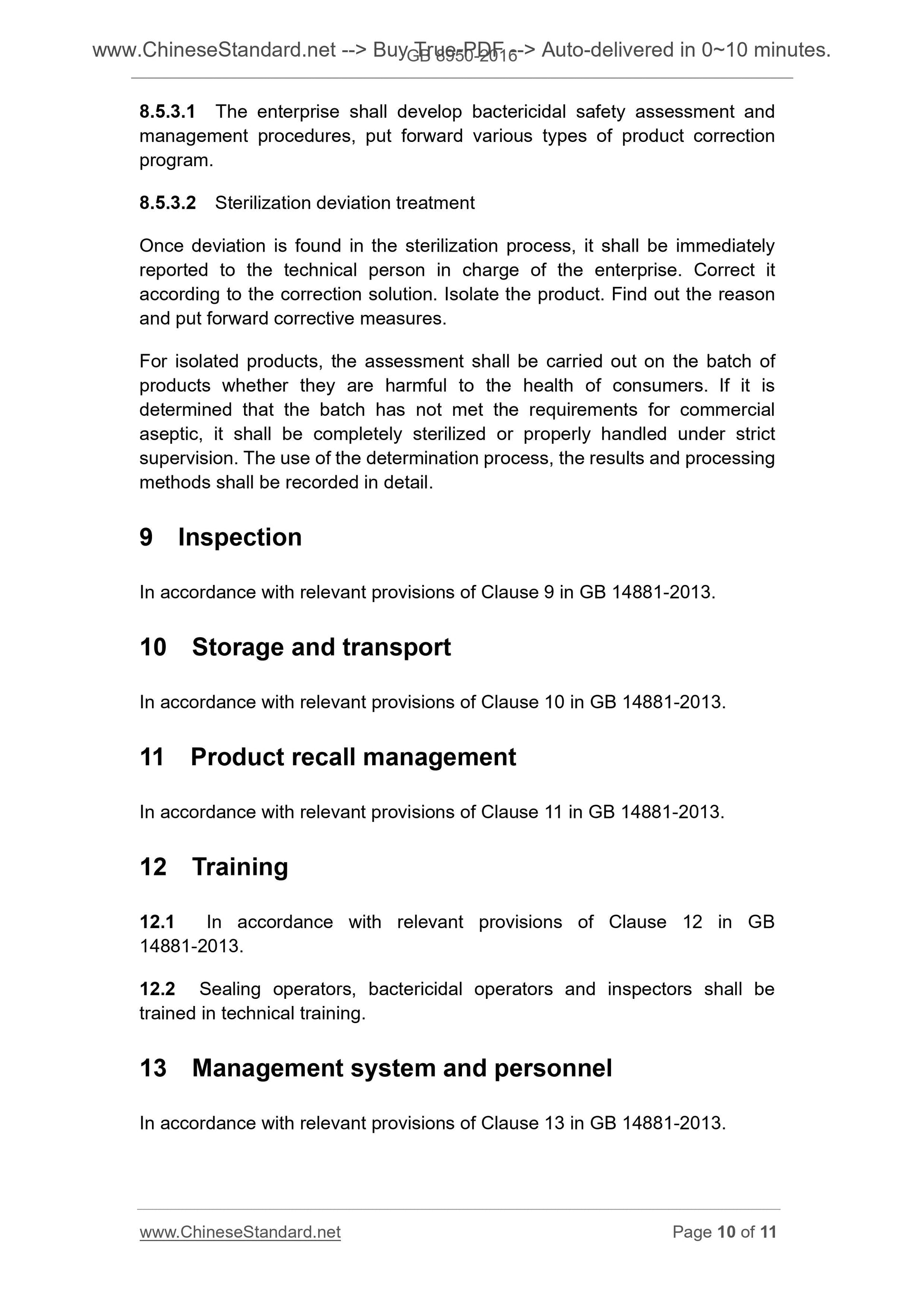1
/
of
6
PayPal, credit cards. Download editable-PDF & invoice in 1 second!
GB 8950-2016 English PDF
GB 8950-2016 English PDF
Regular price
$85.00 USD
Regular price
Sale price
$85.00 USD
Unit price
/
per
Shipping calculated at checkout.
Couldn't load pickup availability
Delivery: 3 seconds. Download true-PDF + Invoice.
Get QUOTATION in 1-minute: Click GB 8950-2016
Historical versions: GB 8950-2016
Preview True-PDF (Reload/Scroll if blank)
GB 8950-2016: Hygienic specifications of cannery
GB 8950-2016
GB
NATIONAL STANDARD OF THE
PEOPLE’S REPUBLIC OF CHINA
National Food Safety Standard -
Hygienic specifications of cannery
ISSUED ON. DECEMBER 23, 2016
IMPLEMENTED ON. DECEMBER 23, 2017
Issued by. National Health and Family Planning Commission of the
People 's Republic of China;
China Food and Drug Administration.
3. No action is required - Full-copy of this standard will be automatically and
immediately delivered to your EMAIL address in 0~60 minutes.
Table of Contents
Foreword ... 3
1 Scope ... 4
2 Terms and definitions ... 4
3 Site and factory environment ... 5
4 Plant and workshop ... 5
5 Facilities and equipment ... 5
6 Hygiene management ... 7
7 Food ingredients, food additives and food related products ... 7
8 Food safety control in the production process ... 8
9 Inspection ... 10
10 Storage and transport ... 10
11 Product recall management ... 10
12 Training ... 10
13 Management system and personnel ... 10
14 Record and document management ... 11
Foreword
This Standard replaces GB 8950-1988 Hygienic specifications of cannery.
Compared with GB 8950-1988, the main changes in this Standard are as
follows.
- modified the standard’s name to “National Food Safety Standard
Hygienic specifications of cannery”;
- modified the empty cans to packaging containers, including relevant
requirements for metal cans, glass bottles, composite flexible bags,
boxes, cups, bowls, bottles;
- added the management requirements for the use of fiber utensils;
- refined the water supply system; respectively made provisions on the
enterprises of urban water supply and distribution network of water
supply and water quality control as well as testing projects of enterprises
with own-water-supply;
- added that the enterprise shall make requirements for sealing
procedures in health control during processing; modified relevant
provisions on the technical procedures for thermal sterilization; deleted
some specific content of sterilization pot and configuration;
- added the provisions on water quality control of sterilization cooling
water of using different water sources and different cooling methods;
- added the technical requirements for bactericidal safety assessment
procedure;
- added the provisions on the heat distribution testing after installation of
sterilization equipment;
- added the cooling requirements. “for some heat-poor products (such as
canned food, etc.) the central temperature can be cooled to below
45°C”.
National Food Safety Standard -
Hygienic specifications of cannery
1 Scope
This Standard specifies the basic requirements and management criteria for
the places, facilities, personnel of raw materials purchasing, processing,
packaging, storage and transport of canned food during the canned food
production process.
This Standard applies to the production of canned food.
2 Terms and definitions
The terms and definitions defined in GB 14881-2013 apply to this document.
2.1 commercial aseptic
a state that the food, after a moderate heat sterilization, does not contain
pathogenic microorganisms, does not contain non-pathogenic microorganism
that can reproduce therein at normal temperature
2.2 sterilization procedures
technical parameters and operational requirements for thermal sterilization
that can make the product meet the commercial aseptic requirements under a
certain production conditions
2.3 residual chlorine (free residual chlorine)
chloride remaining in water in the form of hypochlorous acid, hypochlorite or
chloride ion
2.4 sterilization deviation
any phenomenon that fails to meet the heat sterilization process during the
heat sterilization process
2.5 key factors of thermal sterilization
the nature, characteristics, conditions, form or other parameters affecting the
heat transfer; when these factors change slightly, it shall directly affect the
mg/L. The cooling method is the internal circulation without chlorination.
5.4 Ventilation and temperature control devices
5.4.1 The canned food processing workshop shall be installed with
ventilation equipment so as to keep the air circulation in the workshop. The
process link that produces a lot of steam or fumes during the production
process shall be relatively concentrated. Use a well-ventilated equipment or
other effective handling measures to discharge it from the workshop. The
vent shall be fitted with a corrosion-resistant net cover and kept clean.
5.4.2 Based on different product processing temperature requirements, the
temperature control equipment shall be installed in the canned food
processing workshop.
5.5 Sterilization equipment
5.5.1 Sterilization equipment shall meet the requirements of sterilization
process. Sterilization pot shall be consistent with the provisions of the state
pressure vessel standards.
5.5.2 After sterilization equipment is installed, it shall carry out the thermal
distribution test. it shall be put into use after the thermal distribution is
confirmed uniform. When the heat supply and heat transfer medium are
guaranteed, it shall perform thermal distribution test at least once every three
years. If there is change in this equipment’s structure, pipes, valves,
procedures and when necessary, it shall re-perform the thermal distribution
test.
5.5.3 Sterilization ancillary facilities
5.5.3.1 Temperature indicating device
Each sterilization device shall at least install one mercury thermometer or
other temperature indicating device to determine the sterilization reference
temperature.
Mercury thermometer shall meet at least. minimum scale of 0.5°C, scale
range per centimeter does not exceed 4°C; the mercury thermometer shall
send the legal organization of measurement once a year for verification. It
shall be affixed with a label having record date, validity, inspector, etc.
5.5.3.2 Temperature and time recording device
Each sterilization device shall be equipped with a temperature-time recording
device. The temperature recorded during sterilization shall be equal to or less
than the sterilization reference temperature, not greater than the reference
temperature. If there is any deviation, it shall be recorded. The automatic
8.5.3.1 The enterprise shall develop bactericidal safety assessment and
management procedures, put forward various types of product correction
program.
8.5.3.2 Sterilization deviation treatment
Once deviation is found in the sterilization process, it shall be immediately
reported to the technical person in charge of the enterprise. Correct it
according to the correction solution. Isolate the product. Find out the reason
and put forward corrective measures.
For isolated products, the assessment shall be carried out on the batch of
products whether they are harmful to the health of consumers. If it is
determined that the batch has not met the requirements for commercial
aseptic, it shall be completely sterilized or properly handled under strict
supervision. The use of the determination process, the results and processing
methods shall be recorded in detail.
9 Inspection
In accordance with relevant provisions of Clause 9 in GB 14881-2013.
10 Storage and transport
In accordance with relevant provisions of Clause 10 in GB 14881-2013.
11 Product recall management
In accordance with relevant provisions of Clause 11 in GB 14881-2013.
12 Training
12.1 In a...
Get QUOTATION in 1-minute: Click GB 8950-2016
Historical versions: GB 8950-2016
Preview True-PDF (Reload/Scroll if blank)
GB 8950-2016: Hygienic specifications of cannery
GB 8950-2016
GB
NATIONAL STANDARD OF THE
PEOPLE’S REPUBLIC OF CHINA
National Food Safety Standard -
Hygienic specifications of cannery
ISSUED ON. DECEMBER 23, 2016
IMPLEMENTED ON. DECEMBER 23, 2017
Issued by. National Health and Family Planning Commission of the
People 's Republic of China;
China Food and Drug Administration.
3. No action is required - Full-copy of this standard will be automatically and
immediately delivered to your EMAIL address in 0~60 minutes.
Table of Contents
Foreword ... 3
1 Scope ... 4
2 Terms and definitions ... 4
3 Site and factory environment ... 5
4 Plant and workshop ... 5
5 Facilities and equipment ... 5
6 Hygiene management ... 7
7 Food ingredients, food additives and food related products ... 7
8 Food safety control in the production process ... 8
9 Inspection ... 10
10 Storage and transport ... 10
11 Product recall management ... 10
12 Training ... 10
13 Management system and personnel ... 10
14 Record and document management ... 11
Foreword
This Standard replaces GB 8950-1988 Hygienic specifications of cannery.
Compared with GB 8950-1988, the main changes in this Standard are as
follows.
- modified the standard’s name to “National Food Safety Standard
Hygienic specifications of cannery”;
- modified the empty cans to packaging containers, including relevant
requirements for metal cans, glass bottles, composite flexible bags,
boxes, cups, bowls, bottles;
- added the management requirements for the use of fiber utensils;
- refined the water supply system; respectively made provisions on the
enterprises of urban water supply and distribution network of water
supply and water quality control as well as testing projects of enterprises
with own-water-supply;
- added that the enterprise shall make requirements for sealing
procedures in health control during processing; modified relevant
provisions on the technical procedures for thermal sterilization; deleted
some specific content of sterilization pot and configuration;
- added the provisions on water quality control of sterilization cooling
water of using different water sources and different cooling methods;
- added the technical requirements for bactericidal safety assessment
procedure;
- added the provisions on the heat distribution testing after installation of
sterilization equipment;
- added the cooling requirements. “for some heat-poor products (such as
canned food, etc.) the central temperature can be cooled to below
45°C”.
National Food Safety Standard -
Hygienic specifications of cannery
1 Scope
This Standard specifies the basic requirements and management criteria for
the places, facilities, personnel of raw materials purchasing, processing,
packaging, storage and transport of canned food during the canned food
production process.
This Standard applies to the production of canned food.
2 Terms and definitions
The terms and definitions defined in GB 14881-2013 apply to this document.
2.1 commercial aseptic
a state that the food, after a moderate heat sterilization, does not contain
pathogenic microorganisms, does not contain non-pathogenic microorganism
that can reproduce therein at normal temperature
2.2 sterilization procedures
technical parameters and operational requirements for thermal sterilization
that can make the product meet the commercial aseptic requirements under a
certain production conditions
2.3 residual chlorine (free residual chlorine)
chloride remaining in water in the form of hypochlorous acid, hypochlorite or
chloride ion
2.4 sterilization deviation
any phenomenon that fails to meet the heat sterilization process during the
heat sterilization process
2.5 key factors of thermal sterilization
the nature, characteristics, conditions, form or other parameters affecting the
heat transfer; when these factors change slightly, it shall directly affect the
mg/L. The cooling method is the internal circulation without chlorination.
5.4 Ventilation and temperature control devices
5.4.1 The canned food processing workshop shall be installed with
ventilation equipment so as to keep the air circulation in the workshop. The
process link that produces a lot of steam or fumes during the production
process shall be relatively concentrated. Use a well-ventilated equipment or
other effective handling measures to discharge it from the workshop. The
vent shall be fitted with a corrosion-resistant net cover and kept clean.
5.4.2 Based on different product processing temperature requirements, the
temperature control equipment shall be installed in the canned food
processing workshop.
5.5 Sterilization equipment
5.5.1 Sterilization equipment shall meet the requirements of sterilization
process. Sterilization pot shall be consistent with the provisions of the state
pressure vessel standards.
5.5.2 After sterilization equipment is installed, it shall carry out the thermal
distribution test. it shall be put into use after the thermal distribution is
confirmed uniform. When the heat supply and heat transfer medium are
guaranteed, it shall perform thermal distribution test at least once every three
years. If there is change in this equipment’s structure, pipes, valves,
procedures and when necessary, it shall re-perform the thermal distribution
test.
5.5.3 Sterilization ancillary facilities
5.5.3.1 Temperature indicating device
Each sterilization device shall at least install one mercury thermometer or
other temperature indicating device to determine the sterilization reference
temperature.
Mercury thermometer shall meet at least. minimum scale of 0.5°C, scale
range per centimeter does not exceed 4°C; the mercury thermometer shall
send the legal organization of measurement once a year for verification. It
shall be affixed with a label having record date, validity, inspector, etc.
5.5.3.2 Temperature and time recording device
Each sterilization device shall be equipped with a temperature-time recording
device. The temperature recorded during sterilization shall be equal to or less
than the sterilization reference temperature, not greater than the reference
temperature. If there is any deviation, it shall be recorded. The automatic
8.5.3.1 The enterprise shall develop bactericidal safety assessment and
management procedures, put forward various types of product correction
program.
8.5.3.2 Sterilization deviation treatment
Once deviation is found in the sterilization process, it shall be immediately
reported to the technical person in charge of the enterprise. Correct it
according to the correction solution. Isolate the product. Find out the reason
and put forward corrective measures.
For isolated products, the assessment shall be carried out on the batch of
products whether they are harmful to the health of consumers. If it is
determined that the batch has not met the requirements for commercial
aseptic, it shall be completely sterilized or properly handled under strict
supervision. The use of the determination process, the results and processing
methods shall be recorded in detail.
9 Inspection
In accordance with relevant provisions of Clause 9 in GB 14881-2013.
10 Storage and transport
In accordance with relevant provisions of Clause 10 in GB 14881-2013.
11 Product recall management
In accordance with relevant provisions of Clause 11 in GB 14881-2013.
12 Training
12.1 In a...
Share
